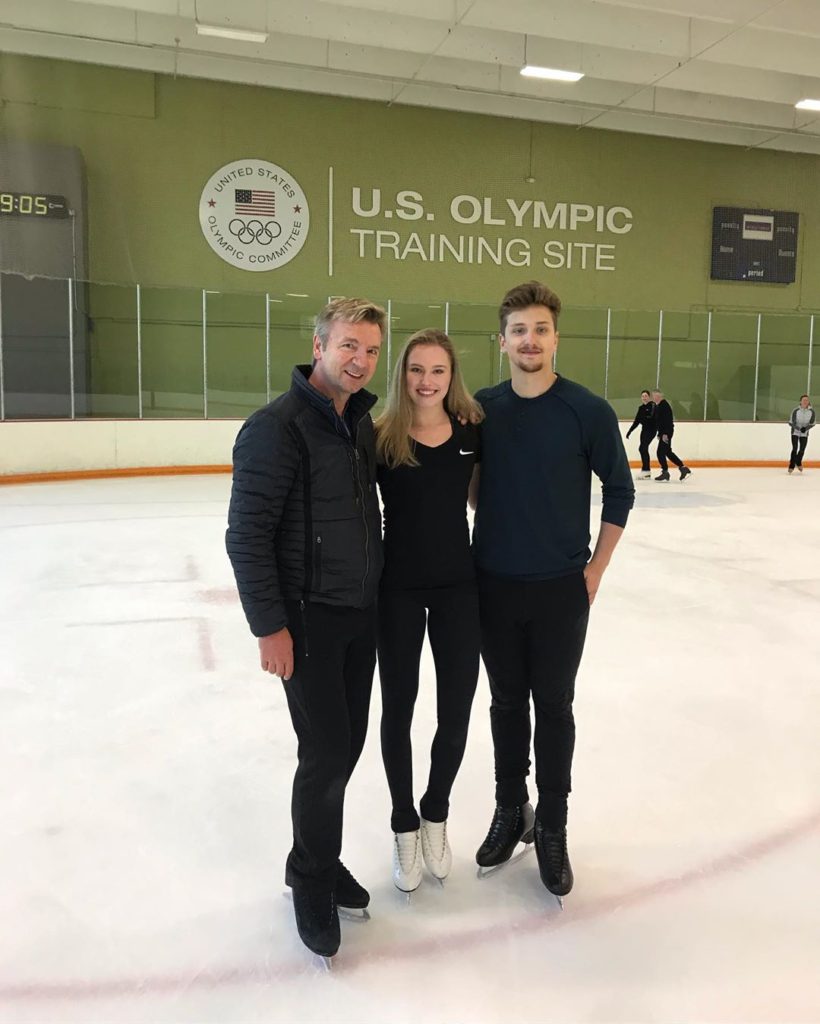by Jacquelyn Thayer
On the last Saturday of January’s US Figure Skating Championships, Christina Carreira and Anthony Ponomarenko skated their final free dance of the 2018-19 season. The following Monday, coach Igor Shpilband was ready with the concept for next year’s program: flamenco.
It’s a natural direction for a young team whose ease with mature Latin-inflected styles, like tango and cha cha in previous short dances, belies their youth as athletes.
“I think off the ice, we’re really happy all the time,” said Ponomarenko. “We have great personalities, very energetic, so I feel like that really translates into our skating. It’s more comfortable for us to skate Latin and flamenco and swing rhythms.”
“It’s easier for us to skate to fast and upbeat music than slow,” agreed Carreira. She cited the team’s recent forays into lyrical free dances as a counterpoint: “We wanted to do something new.”
Preparation for the intricate style has included off-ice work in Carreira’s native Montreal with flamenco dancer Julia Cristina and, too, plenty of film — the myriad flamenco examples available on YouTube as well as skating programs from couples like Tessa Virtue and Scott Moir, Tanith Belbin and Ben Agosto, and Laurence Fournier-Beaudry and Nikolaj Sorensen.
The free dance will be juxtaposed with a Finnstep-based rhythm dance set to Kiss Me Kate‘s “Too Darn Hot,” a selection that took a little more time to land upon but may evoke some past success with blues and swing character. And while Shpilband took the choreographic lead on both programs, the team has consulted as well with Massimo Scali and, during a week in Colorado Springs, Christopher Dean — “a figure skating genius,” in Ponomarenko’s words.
“It was awesome,” said Carreira. “He’s so good at what he does. He makes moves that I don’t think anyone else would think about.”
“Yeah, I think it’s really different from anything we’ve ever shown in previous programs, so we’re really excited for the new season to show everybody our new programs,” said Ponomarenko.

Carreira and Ponomarenko with Christopher Dean, June 2019. (Photo courtesy of Christina Carreira on Instagram.)
Dean, however, is just the latest ice dance legend to enter the duo’s orbit. They’ve been coached by Shpilband, a key figure in US ice dance’s development, since teaming up in 2014, letting them train alongside top international teams like Madison Chock and Evan Bates and Penny Coomes and Nicholas Buckland. Closer to home, Anthony’s parents are Marina Klimova and Sergei Ponomarenko, three-time Olympic ice dance medalists and 1992’s champions.
“Having trained with older skaters, I feel like we got to see what it’s like to train with proper athletes,” he said. “This gave us a foundation to set up our own training schedules. Also, having parents as Olympians gives a lot of extra in depth knowledge that helps us in our skating. We worked with my mom last year on the Tango Romantica and she helped a lot throughout the season.”
But history aside, their curriculum is forward-looking; while off-ice training includes the traditional ballet, it’s joined by hip hop classes, led by fellow ice dancer Yura Min. It’s a style that’s only in recent years become a more standard element of dance work for skaters — particularly given its growing acceptance as a competitive option — and the two believe it confers some key benefits.
“I think it helps us move more freely on the ice,” said Carreira.
“And I think the sport of ice dance has really evolved because of it,” added Ponomarenko. “We’re using music in this day and age that we wouldn’t use ten years ago and it’s really cool to see how ice dance has evolved.”
While they’ve penciled in a season opener at the Lake Placid Ice Dance Championships, they may elect instead to compete at Dance-Pairs Chicago for the second straight year. And in contrast to last year’s jetsetting Grand Prix schedule, which featured two trips to Europe in three weeks, this year’s slate — opening event Skate America and the concluding NHK Trophy — offers some breathing room, allowing for any needed recovery or program adjustments.
Such a schedule may also help towards their initial goal of placing top five at each event — “just because that compares us to teams that are at the same level,” said Ponomarenko. While the couple picked up bronze at their second event last season, the fields this year feature multiple world medalists and similarly-ranked teams on the rise.
That tight squeeze extends to the national field, which currently includes two world medalist couples, three previous world championship competitors, and four other Grand Prix medalists. “Our goal this season is to make the world team, which we’re aware is very difficult because there are a lot of good American teams,” said Carreira. “And we want to skate good performances, better performances each time so we keep improving throughout the season.”
And, she noted, their developmental focus is similarly direct — and ambitious: “We’ve been working really hard on making our programs harder and more memorable.”
